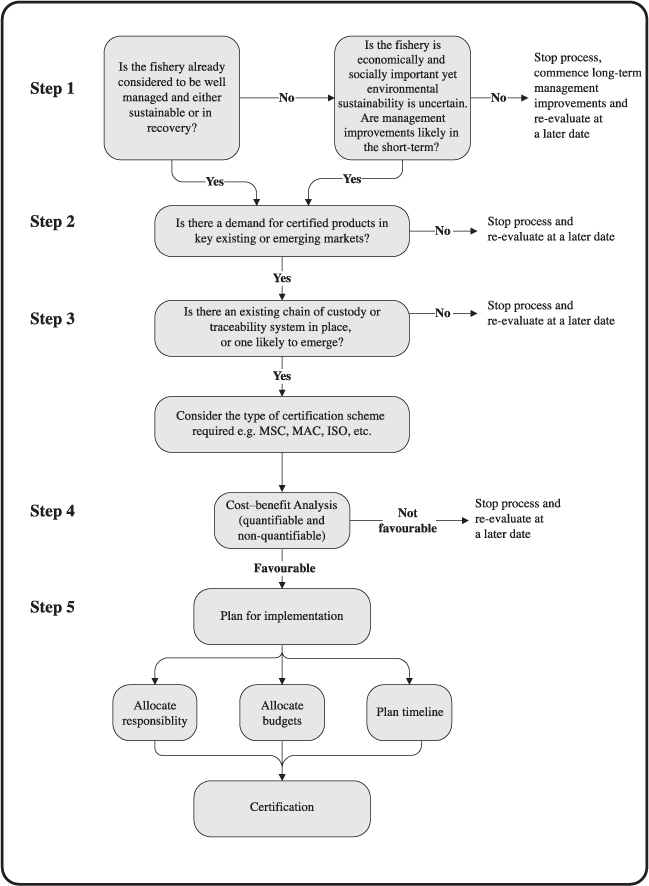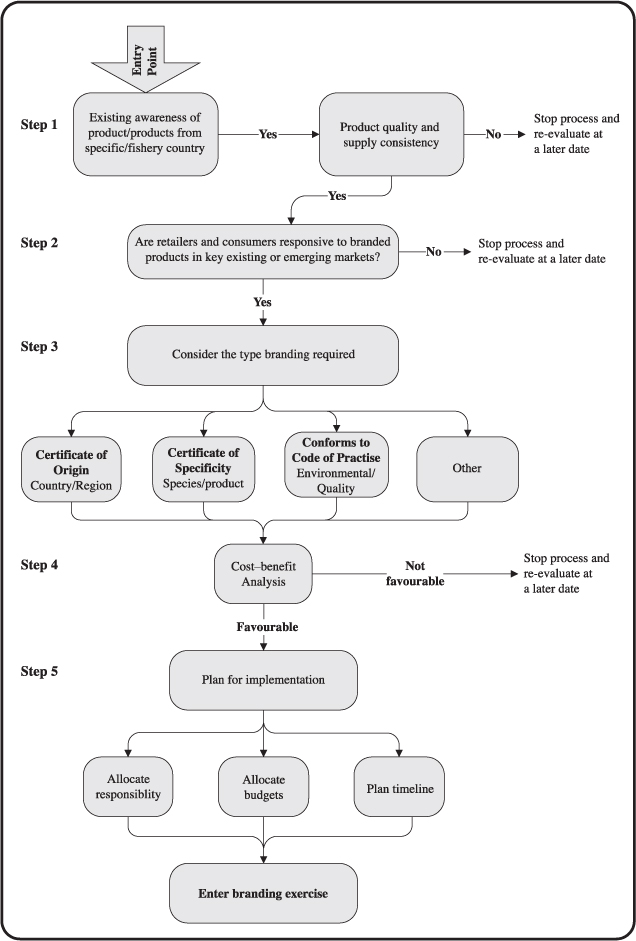Section 3.2 suggests that currently there is perhaps less merit in engaging with social certification due to:
A number of steps are therefore outlined hereunder to assist countries in the Asia–Pacific region to make decisions about whether to engage with environmental certification and/or branding initiatives. This decision-tree is intended for use when short- to medium-term net benefits are achievable (of course in the long-term one would wish all fisheries to move towards sustainable exploitation and resulting benefits). An important point to note about the decision-making tree with regard to environmental certification is that the need for better fisheries management in fisheries which are currently overexploited is taken as a given. This paper is attempting to provide a tool for decision-making about the net benefits of certification, not of improved management. We would therefore argue that in cases of overexploitation, if improved management would/could take place without certification and there would be no/few market benefits (access or price), then certification should not be considered, but rather improved management put in place without any certification.
The individual fishery is already well managed and/or main competitor products are certified; certification would exploit potential benefits (market access/market price, and other benefits such as improved client relationships, niche marketing, and public relations, which themselves could be expected to translate into price or market access benefits). Go to Step 2
The individual fishery is not well managed and/or main competitor products are certified, but the fishery is important economically/socially, and embarking on a certification process would help to ensure sustainability and result in potential benefits (bio-economic benefits from more sustainable fishery that would otherwise not be realized, plus market access/market price). It is realistic (based on political realities, the extent of overexploitation, the size of the fishery etc.) to expect that the necessary improvements in fisheries management could be achieved in the short term, such that certification would then be likely.
If yes, go to Step 2.
If no, stop the process, initiate longer term plans for improvement management and re-evaluate after longer term improvements in management have begun to make meaningful changes.
Existing awareness of the product/species from the fishery/country by buyers/consumers is already high and quality is perceived to be good. The product/species is important in economic/social terms for job creation and income generation. Potential appears to exist (i.e. the product/species appears to have unique characteristics that could be exploited) to use branding or quality marks to realize potential benefits. Go to Step 2
The product/species is important in economic/social terms for job creation and income generation. Potential appears to exist to use branding or quality marks to realize potential benefits, but current aspects potentially associated with the brand, e.g. quality, are poor. It is realistic to expect that improvements could be made in the short term, such that effective branding would be possible, e.g. if the emphasis of the brand is on quality, quality can be improved.
If yes, go to Step 2.
If no, stop the process and re-evaluate after longer term improvements have begun to make meaningful changes.
Are products from the fishery being sold to countries/markets where there are certified suppliers, or there is likelihood of existing suppliers wanting to engage in chain-of-custody certification? (This may require consultation with suppliers.)
_____
22 This should include both international, regional and domestic markets.
If yes, go to Step 3.
If no, stop the process and re-evaluate at a later date as supplier response to environmental certification changes over time
Are products being sold into countries/markets that already demonstrate demand through sales of certified products from other fisheries, there is stated demand from supermarkets (see Section 3.1) and/or general consumer concern for environmental issues (see Section 4)? This may require consultation with existing retail/wholesale outlets in destination markets and literature reviews.
If yes, go to Step 3.
If no, stop the process and re-evaluate at a later date as market response to environmental certification changes over time.
Are products from the fishery/country being sold to countries/markets where consumers are generally thought to be responsive to branding/quality, and where there is potential for branding to differentiate products from those of other suppliers/countries? This may require assessments of macroeconomic conditions (e.g. economic cycles/depressions), price elasticities of demand, consultation with retailers and consumer surveys about demand for branding/quality marks, consideration of issues related to economies of scale, etc. Assessment of potential at this stage should carefully include all the potential risk factors and barriers identified in Section 7.2
If yes, go to Step 3.
If no, stop the process and re-evaluate at a later date as market response changes over time.
Steps 1 and 2 could be completed, at least in an initial and participatory way, during the APFIC meeting. The authors of this paper do not presume, based on the small desk-study exercise to complete this paper, to have sufficient information on fisheries/products in the Asia–Pacific region to enable identification of suitable candidates for certification/branding. We therefore suggest Table 4 as a starting point for use in the APFIC meeting. Additional rows could be added to the table as necessary based on the views of participants as to key requirements for either certification or branding. Then once agreed, participants from each country could insert a number of fisheries or products in the columns, tick boxes where these fisheries/products are thought to comply with the required characteristics and then assess whether the fisheries/products appear to be good candidates for certification or branding. As such it would represent the tentative completion of Steps 1 and 2, noting that additional research would be required.
Based on the species concerned, production method, views of buyers and a review of certification requirements and likely costs, choose between:
Consider whether branding:
If the cost–benefit analysis produces favourable results, go to Step 5.
If not, stop the process and re-evaluate later.
This final step represents a crucial stage in successful engagement with certification or branding. Too often in the fisheries sector, policy or management decisions are made, without sufficient attention to the detailed planning required for implementation. Key implementation steps should include:
The five certification evaluation steps are presented in Figures 9 and 10.
Figure 9: Decision-tree — environmental certification

Figure 10: Decision-tree — branding
